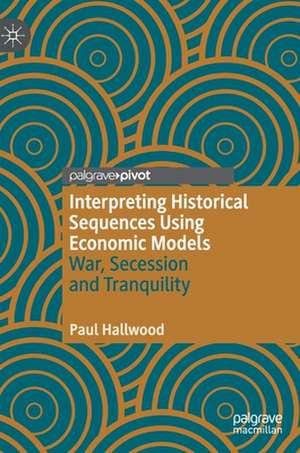Interpreting Historical Sequences Using Economic Models: War, Secession and Tranquility
Autor Paul Hallwooden Limba Engleză Hardback – 6 oct 2020
Preț: 384.09 lei
Nou
Puncte Express: 576
Preț estimativ în valută:
73.50€ • 76.58$ • 60.85£
73.50€ • 76.58$ • 60.85£
Carte tipărită la comandă
Livrare economică 03-17 aprilie
Preluare comenzi: 021 569.72.76
Specificații
ISBN-13: 9783030538538
ISBN-10: 3030538532
Pagini: 126
Ilustrații: XIII, 126 p. 21 illus.
Dimensiuni: 148 x 210 mm
Greutate: 0.32 kg
Ediția:1st ed. 2020
Editura: Springer International Publishing
Colecția Palgrave Macmillan
Locul publicării:Cham, Switzerland
ISBN-10: 3030538532
Pagini: 126
Ilustrații: XIII, 126 p. 21 illus.
Dimensiuni: 148 x 210 mm
Greutate: 0.32 kg
Ediția:1st ed. 2020
Editura: Springer International Publishing
Colecția Palgrave Macmillan
Locul publicării:Cham, Switzerland
Cuprins
1. Introduction.- 2. The Economic Model.- 3. Intra-State Sequencing with Historical Examples.- 4. Drivers of Historical Sequences.- 5. International Sequencing with Historical Examples.- 6. Peacekeeping and Sequencing.- 7. Case Study: Secessionist Motives in the American Civil War.- 8. Minimizing the Cost of Union: Fiscal Autonomy and the Case of Scotland.- 9. Conclusions.
Notă biografică
Paul Hallwood is Professor of Economics at the University of Connecticut, USA. He has co-authored two books and several papers on Scottish independence.
Textul de pe ultima copertă
This Palgrave Pivot presents theoretical models that explain common historical sequences, such as wars of secession, the rise and fall of empires, and international war. The book uses a rational choice model to frame the incentives of specific groups coming together in a polity or leaving it. These incentives are then set in a theoretical framework to determine the outcome—unity or secession, peace or war—and are demonstrated through historical examples. The book provides two longer case studies looking directly at motives for and against secession: the first on the American Civil War from the point of view of the Confederacy, and the second on efforts by the UK government to stem the tide of Scottish independence. Another case study discusses peacekeeping as aimed at reducing the costs of secessionist wars. With its accessible use of economic theory and ability to bring to life real-world examples of conflict and secession, this book is ideal supplementary reading for courses in international relations, conflict studies, global economics and economic history.
Caracteristici
Presents a theoretical model that explains common historical sequences, such as the growth and decline of empires, wars of secession and achievement of tranquility between nations Refers to many historical cases Incorporates elements from rational choice frameworks and game theory Includes three extended case studies on peacekeeping, the American Civil War and Scottish independence
